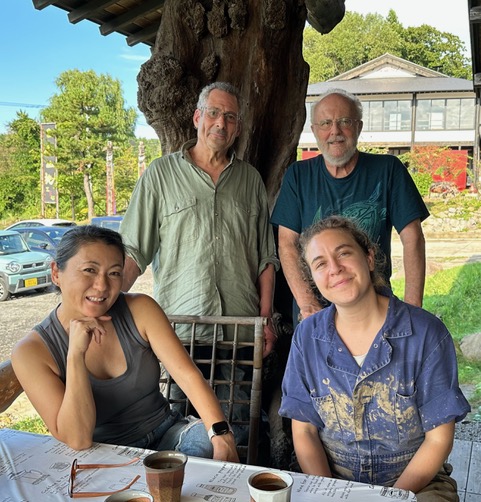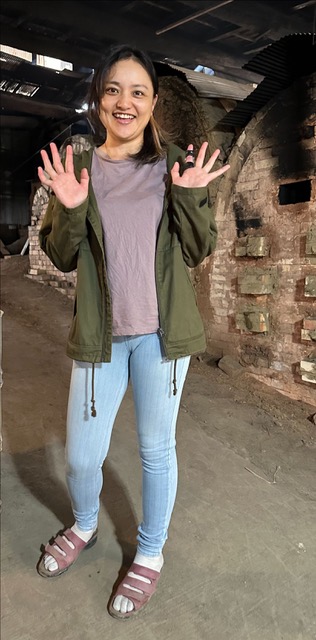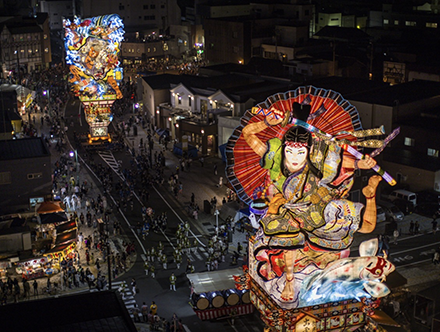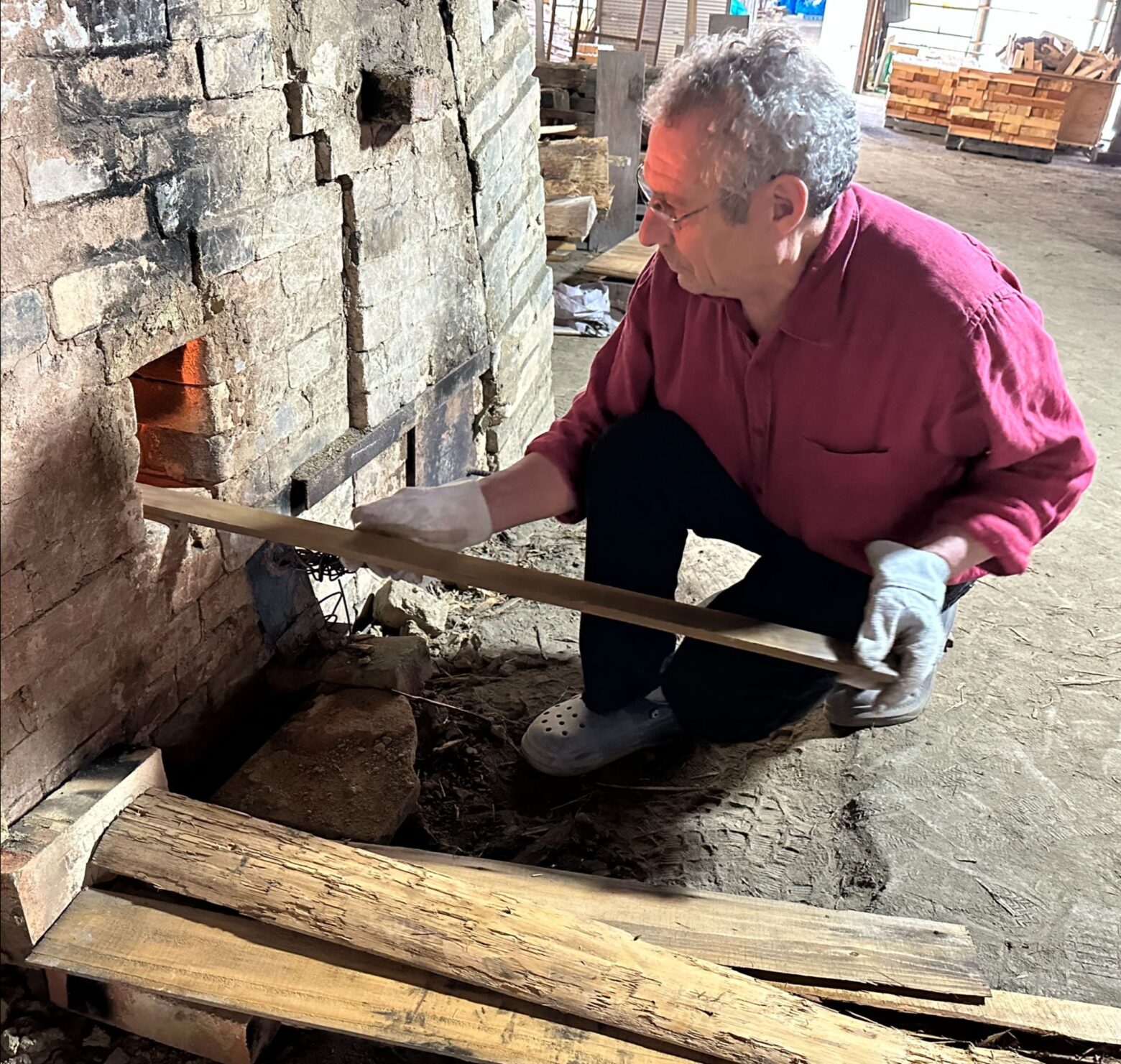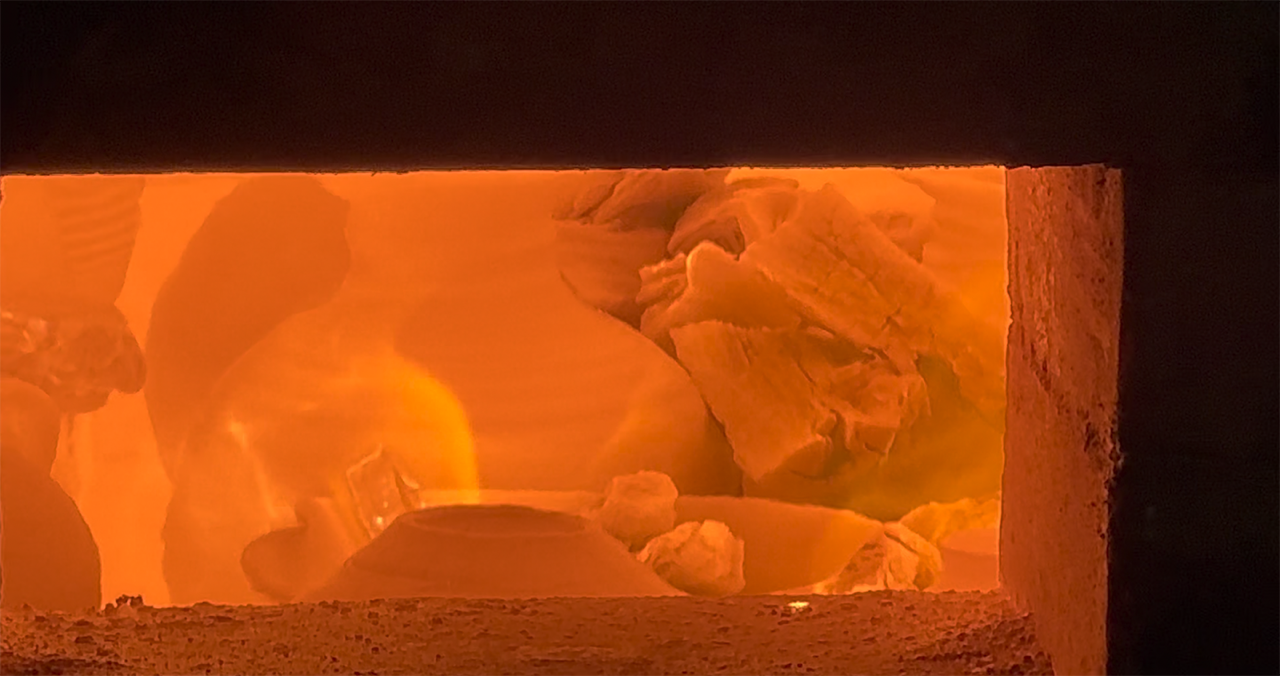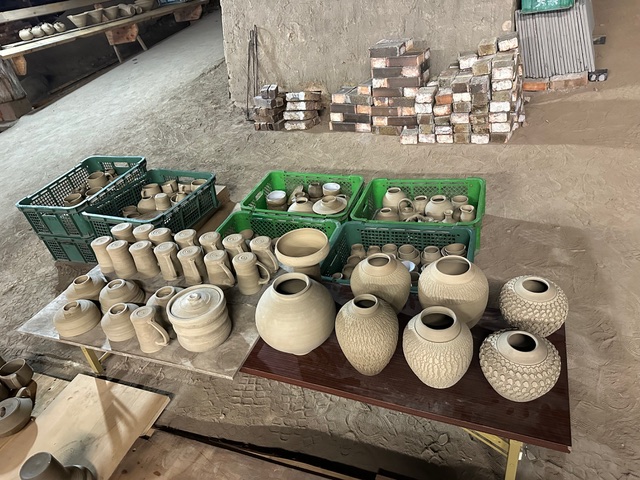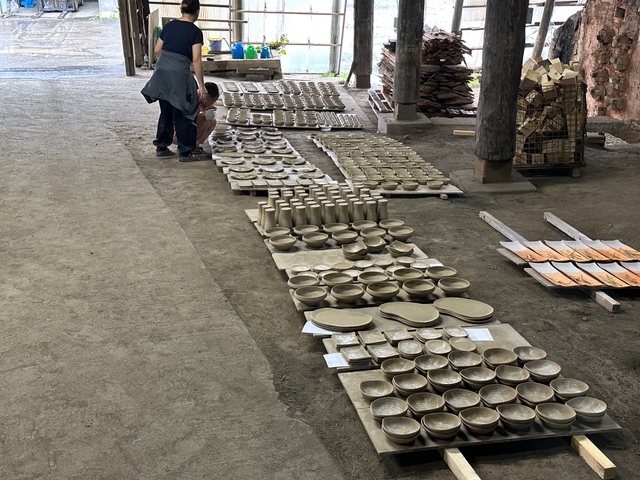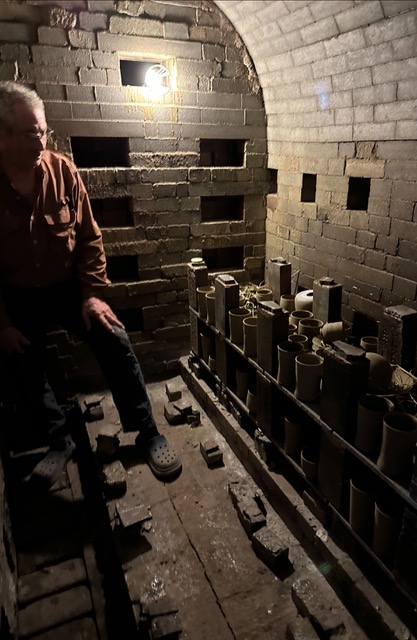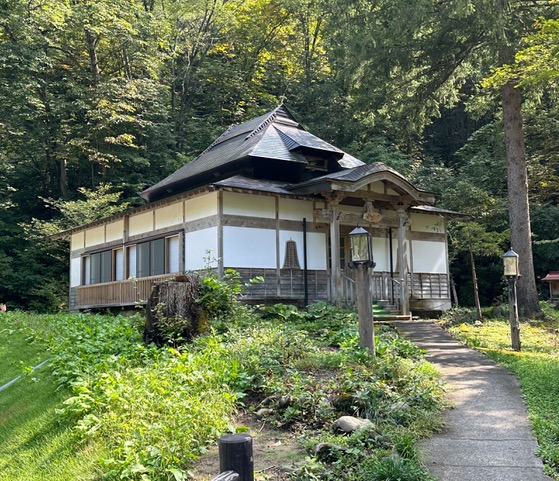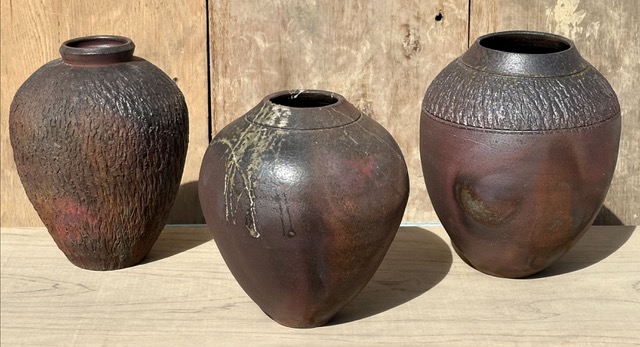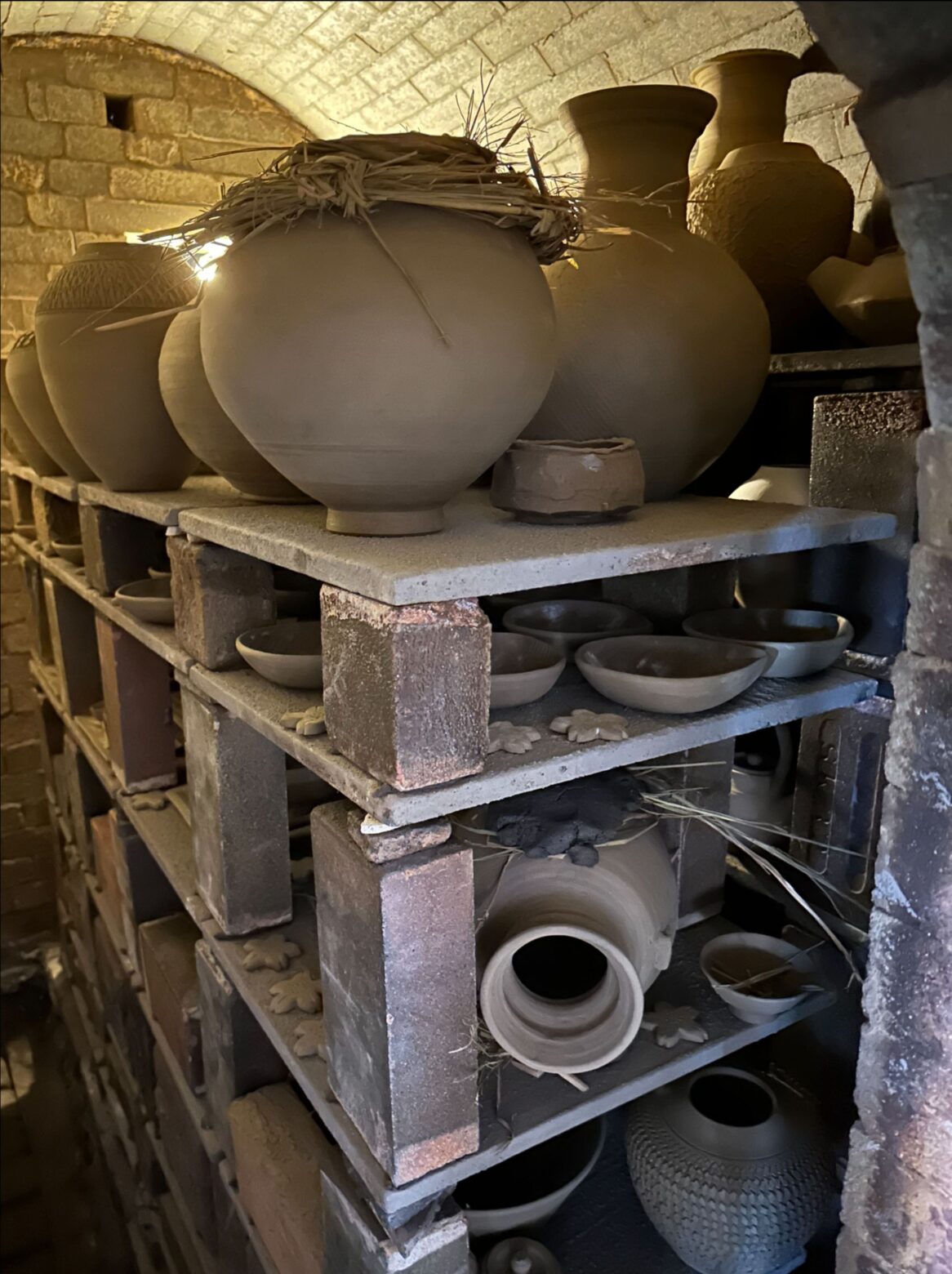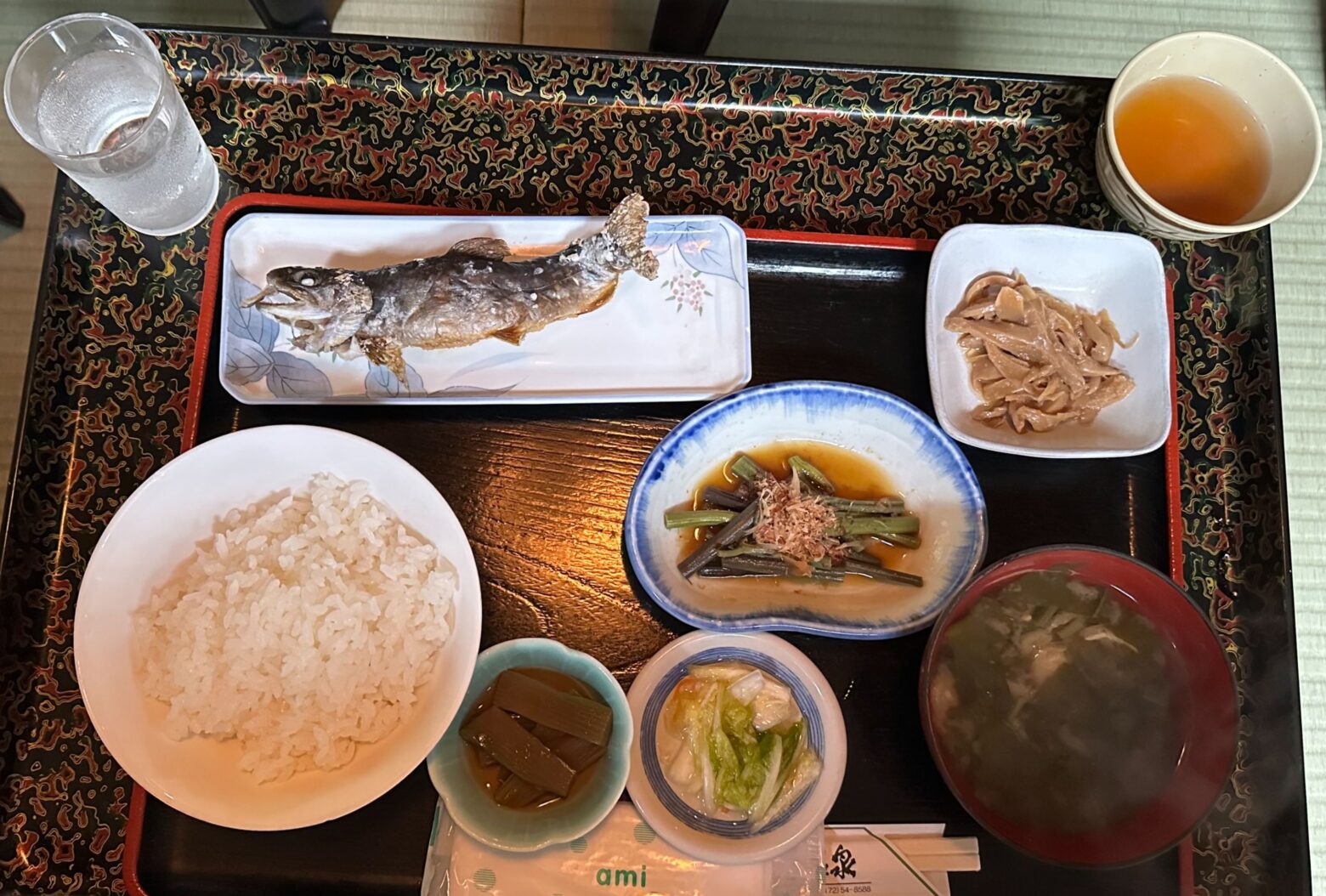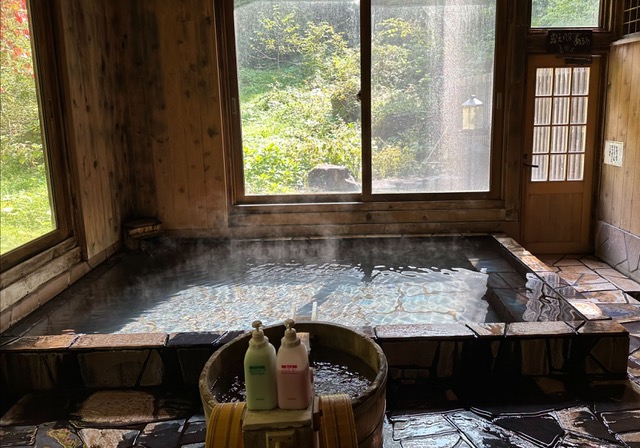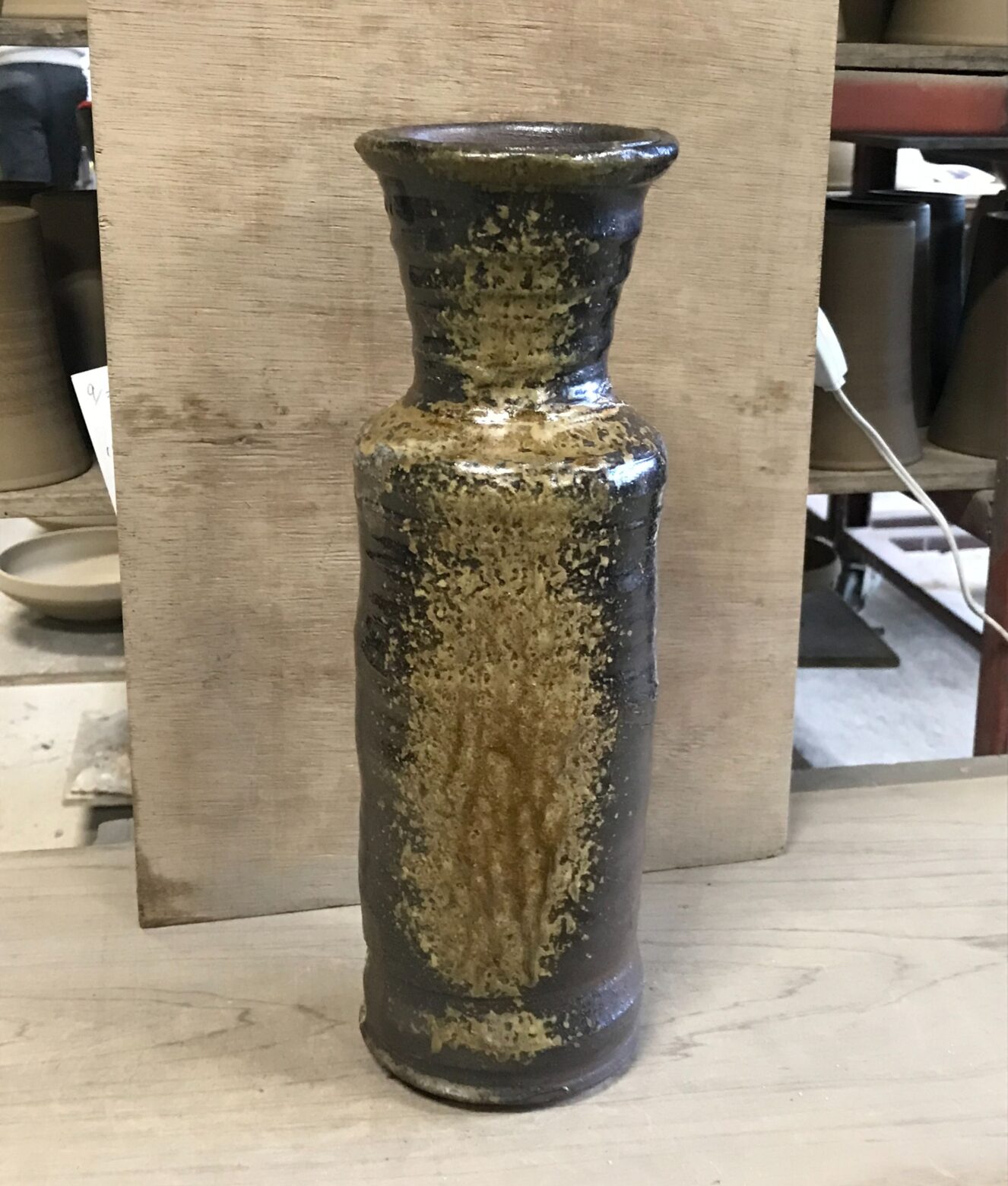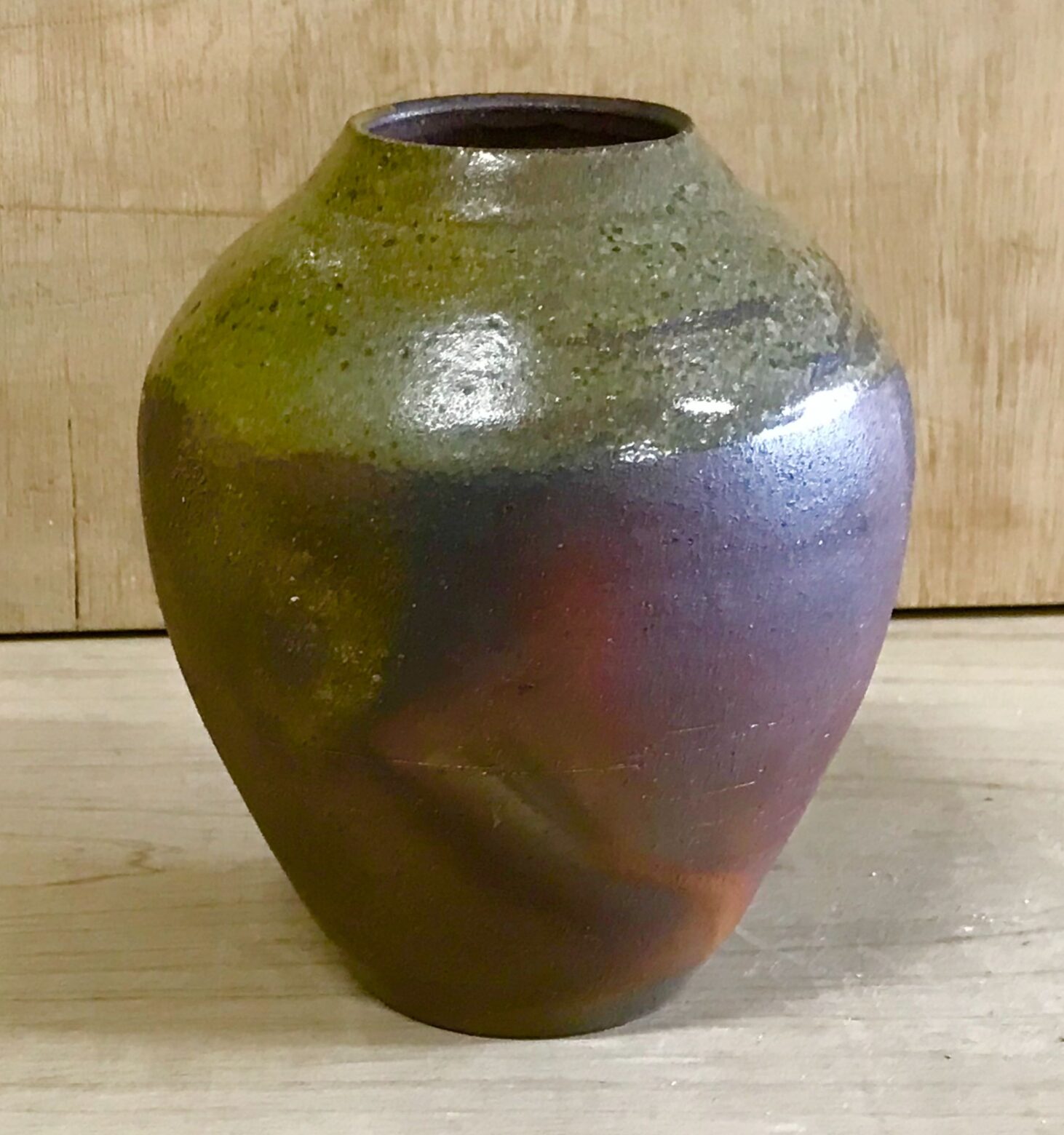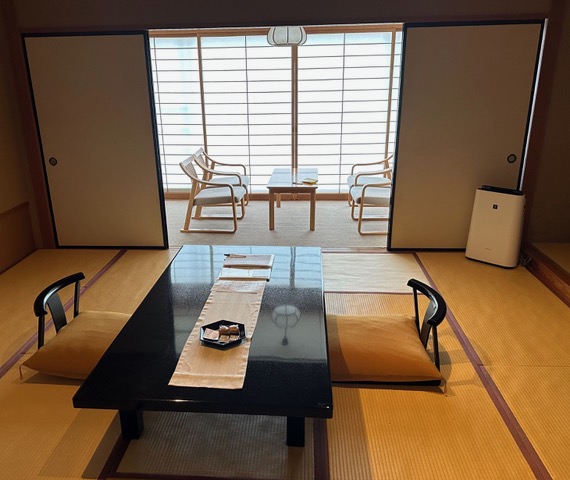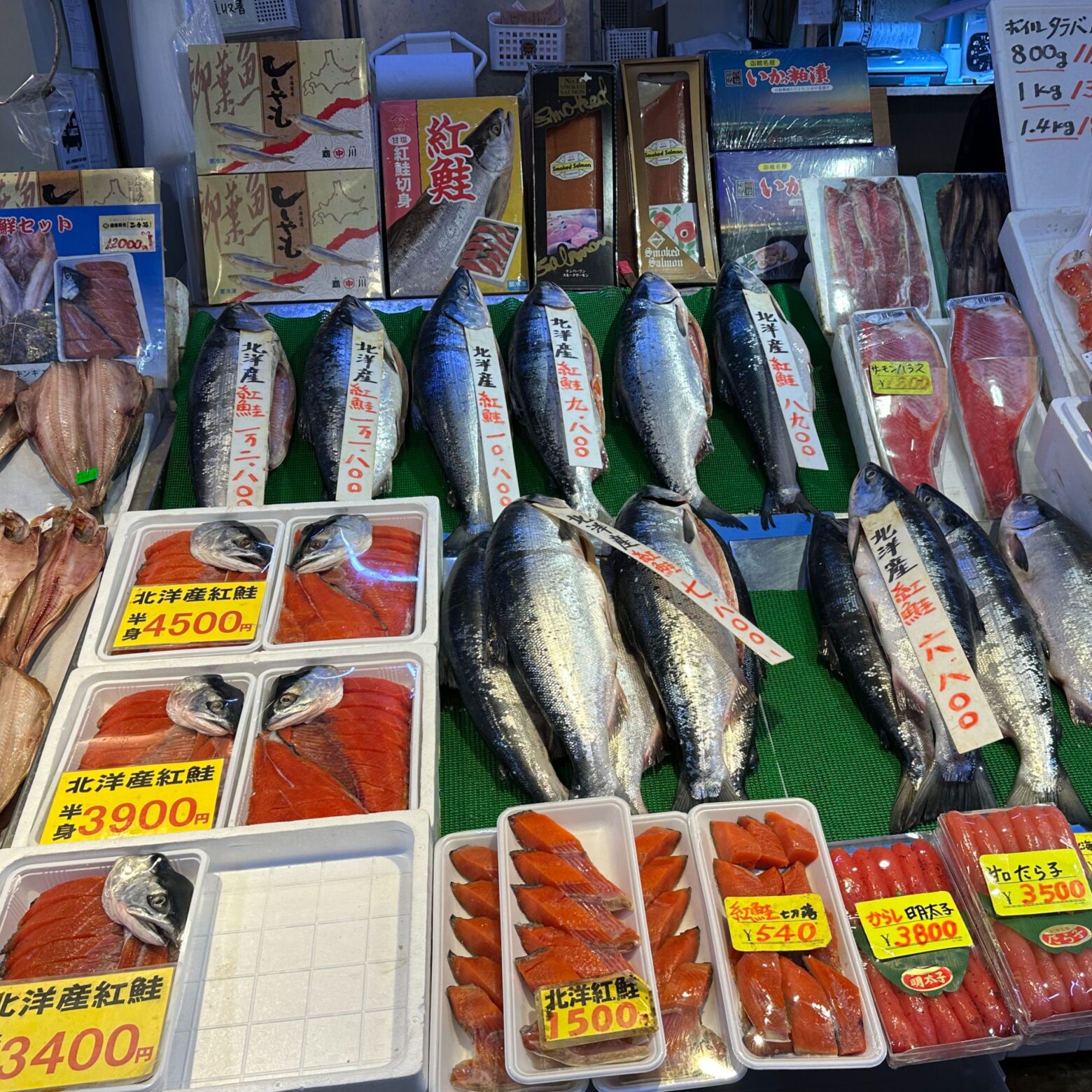
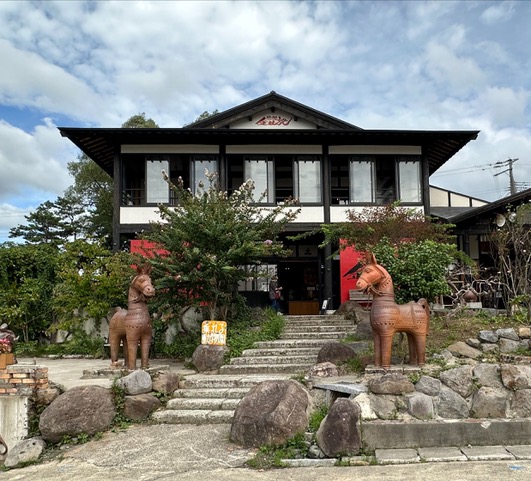
Lee Middleman’s Journal
SHARING THE EXPERIENCE OF A TRADITIONAL WOODFIRING IN AMORI, JAPAN
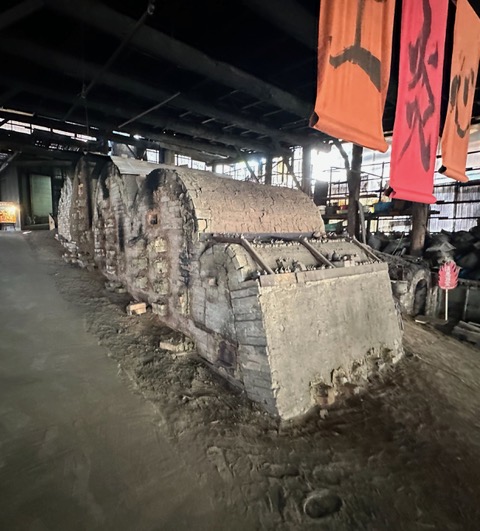


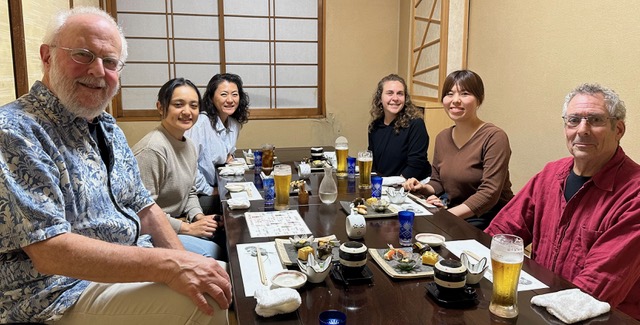
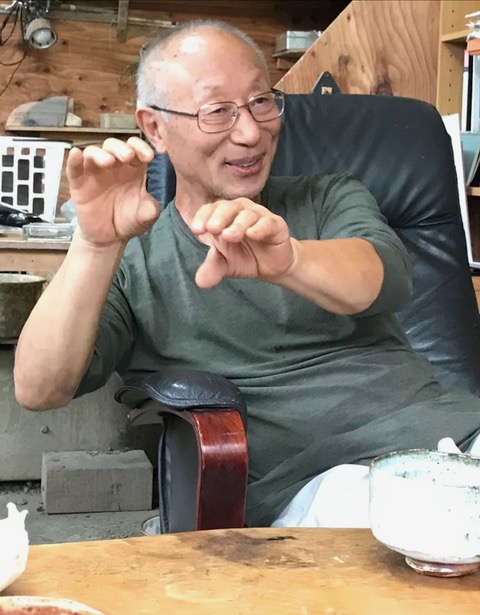

For September, 2023, I organized a 3-week woodfiring workshop in Aomori, Japan at the Tsugaru Kanayama studios of my friend Ryoji Matsumiya. I have known Ryoji for over 20 years and have worked at Kanayama more than 15 times. Here is brief journal of our experiences.
Day 1: Kanayama Pottery was having a ceramics festival starting today for 9 days. Miki Shim-Rutter and Chelsea Fried both members of ACGA, Alan Lacovetsky from Manitoba and I demonstrated as our part of the festival activities. We had great fun interacting with visitors/customers.
Days 2 thru 7: Making work and enjoying the pottery and town of Goshogawara.
We made many pieces: teapots, cups, bowls, vases, and tea bowls. We needed to stop making and allow these to dry enough to fire. We “once fire”, no bisque firing, so pieces needed to be bone dry when loaded. Since we “candle” overnight (low heat) we can put some smaller thinner pieces in that are not quite dry.
Days 8 thru 10: Throwing, trimming and assembling continues, but we manage some sightseeing.
Visited the Jomon period archeological site, Sannai-Maruyama Museum. It contains the ruins of a very large Jōmon period settlement and thousands of pieces of pottery. 3900 BCE to 2000 BCE. Amazing.
The Goshogawara Nebuta Museum is a must visit. Every summer, the world’s tallest paper sculptures, known as Tachineputa, parade through Goshogawara City. The 23-meter-high illuminated creations, weighing 19 tons in total, feature legendary samurai warriors and folk heroes. They are pulled and pushed by up to 50 volunteers. Each sculpture takes an entire year to create.
Days 11 & 12: Preparing and loading the kiln is a two-day effort. We were responsible for the first chamber, while the pottery staff loaded and fired the remaining three chambers. Loading in a tight space with fragile greenware (the pieces are only fired once) and heavy shelves is a strenuous job. Miki and Alan loaded most of the ware with Chelsea and me selecting and passing work and shelves to them. Thanks Miki and Alan.
Days 13 thru 15: Using pine wood, we maintained a rise of 30C per hour. Since the work is not glazed, this local clay must be fired to a high temperature (cone 13 flat) to be tableware. Working in two-person 4-hour shifts, we got to temperature in 24 hours. We then soaked the kiln at cone 13 and then added charcoal for color.
Day 16: While we waited for the kiln to cool for 3 to 5 days, we now explored more of Aomori prefecture. Off to a hot springs onsen to relax and enjoy the country side. This onsen is a great experience in the winter with 6 feet of snow and only oil lamps for light at night. This time I settled for a day visit. Great local food.
A visit to the Hirosaki Castle gives you a feel of the samurai days. It is a hirayama-style Japanese castle constructed in 1611. Built on the top of a hill, it is easier to defend.
Days 16 thru 18: With time on our hands, we decided to go to Hakodate City on Hokkaido, Japan’s northernmost island. It is an easy fast shinkansen train ride from Aomori City. Hokkaido is famous for its seafood. Looming over the town is 334m-high Mount Hakodate. The mountain’s summit, reachable by aerial ropeway gondola, offers dramatic nighttime views. Alan and I stayed in a hotel in a washitsu, a Japanese-style room. Very pleasant and relaxing.
Days 19 to 21: Returning to Kanayama, we cleaned our studio and residence. We made a quick stormy trip to the sea to savor fresh, grilled squid and an onsen by the sea. The day before we left, it was exciting to open kiln. The firing was a success, meaning we were happy with many pieces and learned from our mistakes and experiments.
We were blessed with good friends, good weather, good clay and a good firing.
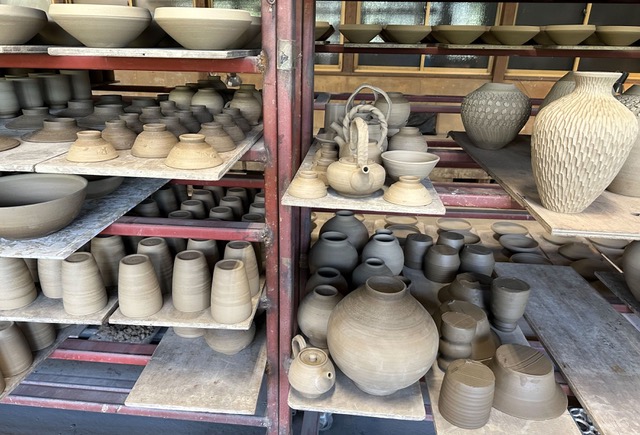
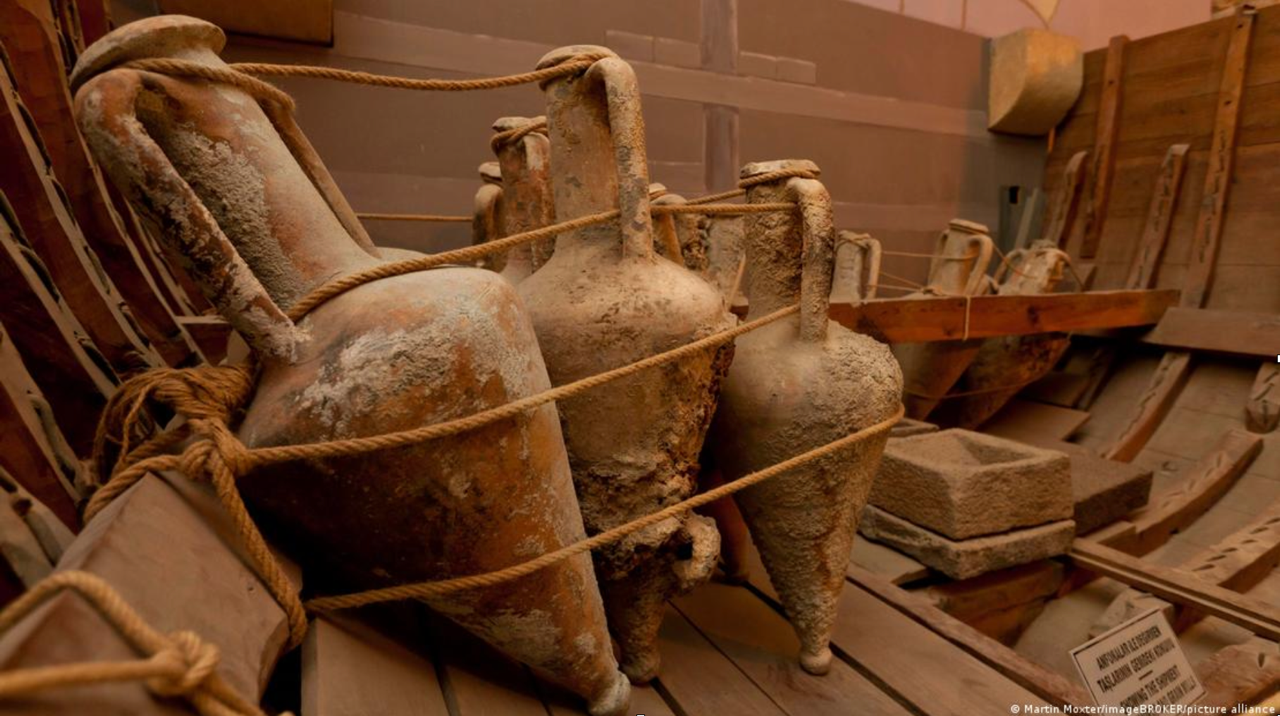
I GREW UP AROUND ANCIENT ARCHAEOLOGY SITES AND I STILL HAVE LOTS OF QUESTIONS
By Khaled Nikro
The amphora is an ancient clay vessel with a pointed base used to transport wine, honey, pickles, olive oil, and more, on ships. As a potter and archeology buff, I wanted to know why it was the shape it is and how it was constructed.
Why is it pointed? Let’s get this question out of the way— it’s not to stick it in the sand, which is the biggest misconception. After all, clay vessels are not known to run away from their owners, nor needing to be balanced if they had a flat foot.
This question vexed me ever since my childhood in Lebanon. The country’s seaside is dotted with ancient trading ports and whenever there was a construction dig, these amphoras, or amphorae, other clay vessels and ancient artifacts would undoubtedly be found.
Fast forward thirty some years, I was done with my Master’s degree in engineering and contemplating whether to go for my PhD.
But I realized those learning ceramics in the university I was going were having way so much more fun than they would be in the engineering department. I was jealous… and the decision was made, no PhD and ceramic courses at the local junior college, it is.
So why are amphoras pointy? The answer is purely functional and for a very smart reason: maritime transport. They were stacked in layers in the hull of a ship and one piece would stack in the space between four amphoras at the layer beneath. See image left: it’s key to note that the floor of the ship was not flat, and having a small, pointed base allowed the vessels to adjust to the topography of the floor and optimize stacking!
This formation provided a secure structure in the hull of a boat which would undoubtedly be unstable during navigation especially in severe weather conditions.
So that’s it? Is that all there is to an amphora? Of course not, these unique vessels hold a trove of knowledge about ancient trade routes, economies, and standardization.
Thanks to modern archeology, a pottery shard can hold a wealth of knowledge about trade routes and sometimes content of the vessel.
How about for storage? This seems to be an efficient way to store liquids. That, however, seem to be less likely, as they were very porous. They were used at maximum twice for transport, then broken into a big mountain size pile, aka amphora graveyard!
Note: Tree resin residue was found in some amphoras seemed to have been an attempt to seal the surface and negate the porosity. The resin, however, changed the taste of the wine and made it less savory.
So that’s it? Is that all there is to an amphora? Of course not, these unique vessels hold a trove of knowledge about ancient trade routes, economies, and standardization.
Thanks to modern archeology, a pottery shard can hold a wealth of knowledge about trade routes and sometimes content of the vessel.

Khaled Nikro holds an amphora he made as part of his research into the construction methods of ancient pottery.
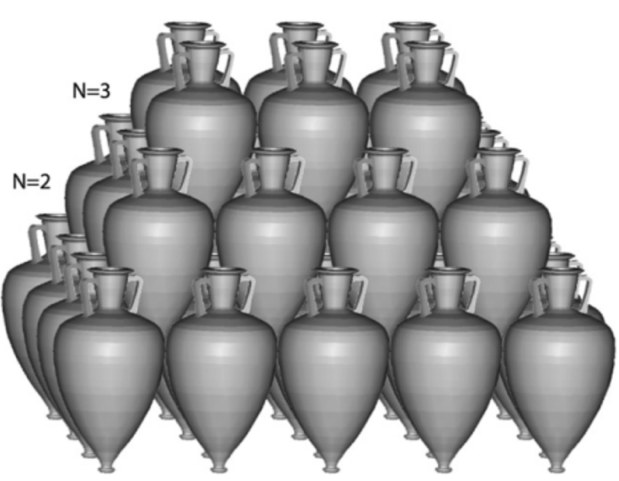
Amphorae stacking: Hein et al, Journal of Archaeological Science 35 (2008) 1049 - 1061

Amphora Graveyard Photo courtesy of Imperium Romanum
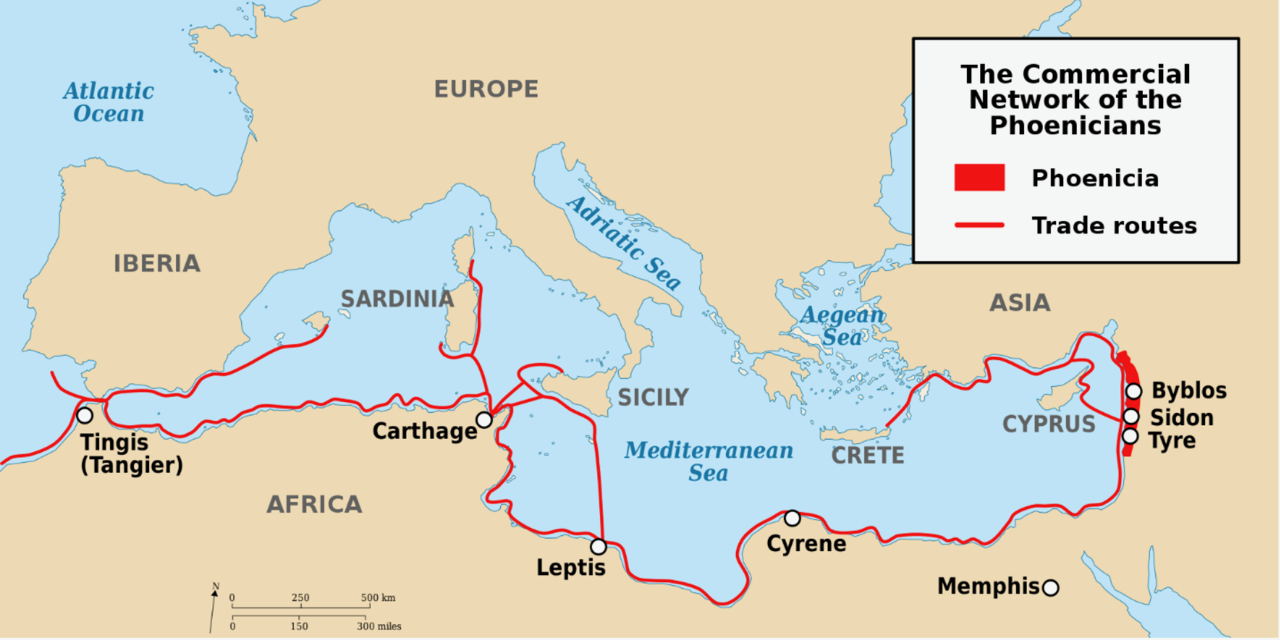
But how on earth can a mere shard have any telltale clues about where it came from? It’s the fascinating process of ceramics petrography where engineering meets archeology. An arche-ologist finds a shard on the shores of Crimea, gets excited beyond belief and takes it to the lab. After careful cleaning, a sample is then extracted from the shard and ground to less than 100 microns fine grain (A micron is 1/1000 of a millimeter). The mineral and metallic contents ratios are then examined under a real fancy microscope and recorded.
These ratios are well documented to specific regions and specific kiln sites throughout the Mediterranean and Black Sea. The archeologist is now ecstatic to know that the shard is from a Sinopean Carrot (because it looks like a carrot) amphora from a city called Sinop in modern day Turkiye.
Modern science is now also allowing us to extract samples of the content that came in contact with the shard: olive oil, honey, wine, pickles, etc.
Now that we know that these vessels played a crucial role in ancient trade, we can use that knowledge to infer the significance and size of economies.
Much to the chagrin of their sailors and to the joy of modern day archeologists, complete shipwrecks are often found in the bottom of these trade routes. Considering the size of the cargo, possible content, origin and destination, how many trips can the weather allow per year and other factors, archeologists can estimate the size of the trade and the wealth of a region as sometimes corroborated with historical accounts and clay tablets.
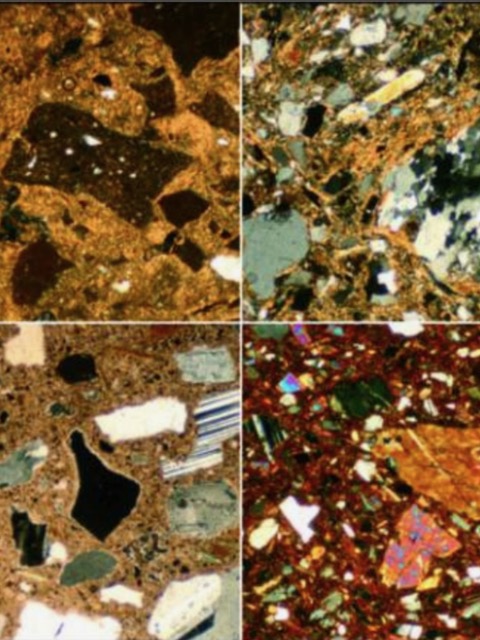
Examples of ceramic pertrography
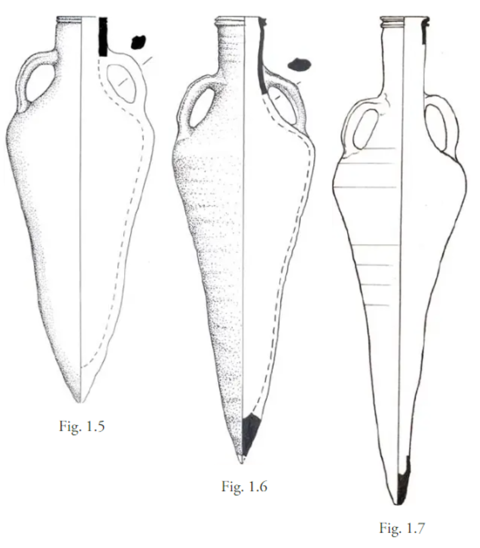
Sinopean carrot amphoras
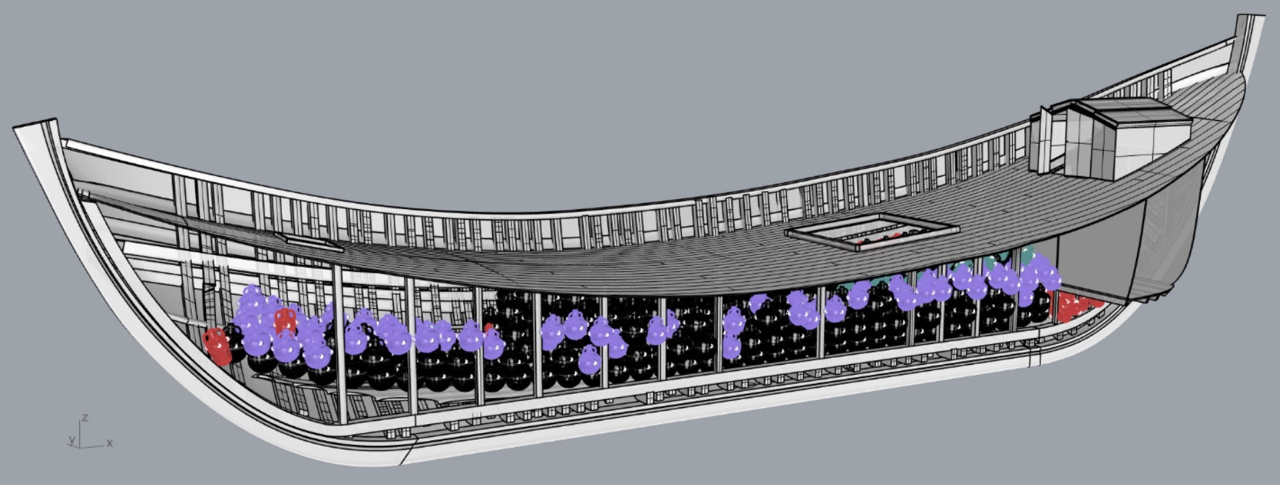
A shipwreck might have held 200 amphorae but how was the value determined? When a merchant buys 200 Byzantine amphorae, they need to know the exact amount of wine they are getting.
When the Byzantine Church chipped in 2 large cargos of wine from their vineyards to finance Heraclius’ war against the Persian empire in the 7th century, they needed to keep track of that wine quantity so that Heraclius will never hear the end of it. https://medlab.stanford.edu/projects/yassiada
A method of standardization must then be in place. In other words, a gallon of milk is the same quantity of milk wherever the one gallon unit is used. This means that the volume has to be the same, and so is the case for these amphoras. This prompts another conversation about forming methods with which a potter can produce same size/volume amphora and within what accuracy, why a certain shape was used vs. another, how fast can they be produced, etc.
Clay vessels are now at the heart of the topic of standardization in antiquity. Archeologists employ cutting edge modern technologies to conduct fascinating studies on this topic.
The Yassiada shipwreck is one of the two cargos from the Byzantine church that did not survive the trip and its content is researched extensively by the MedLab at Stanford University Department of Classics.
THROWING AN AMPHORA
You can’t possibly throw a pointy bottom form like that, on a wheel, and I couldn’t get straightforward answers on the web. The best I could do was to speculate, test on the wheel and access academic papers. A small to mid size wheel thrown amphora is likely thrown in 3 steps:
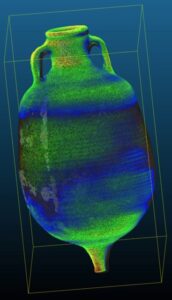
https://medlab.stanford.edu/projects/amphora-standardization
Step 1: Form the top 80-90% of the body as usual.
Step 2: Flip it upside down on a chuck after the top dries and then use the (still wet) bottom portion to form the pointy bottom.
Step 3: Attach handles.
But this was not always the case for different shapes and sizes. Some amphorae held 50 litres and they would be impossible to throw on the wheel. Remember, no electric wheels back then and it becomes a tour de force to center 25 lbs on a kick wheel. Potters then need to resort to coil/throw, coil/paddle, throw/paddle, multiple sections techniques to achieve bigger volumes and certain shapes.
Archeologists today have cutting edge technologies that allow them to perform detailed 3D scans of the inside and outside of the amphorae. Advanced geometry healing algorithms are then used to smooth out nicks and materials build up on the surface of the vessel to get an accurate representation of size, volume, thickness, forming methods.
About the author: Khaled Nikro is a daytime engineer and nighttime potter. He teaches and fires at Higher Fire in San Jose.

Nathan Lynch in the studio
NATHAN LYNCH CERAMIC SCULPTOR

In San Geronimo, two monumental vertebrate obelisks stand sentinel in front of the home of sculptor, performance artist and professor Nathan Lynch. Scattered in their glossy presence are dozens more. Puffed-up podiums and deflated, cratered soap boxes, a five-foot-tall drooping trophy, bathtubs with ceramic bubbles at their feet and an army of amorphous blobs that look equal parts Dr. Seuss and David Cronenberg, depending on where you stand.
Lynch, whose work is currently on view in a three-person exhibition organized by the design firm Studio Ahead for the SF-based Jones Institute, has been the chair of the ceramics program at California College of the Arts since 2006. Wry and nonchalant, the 49-year-old has a professorial demeanor and abundant energy, evidenced by the work strewn across his property. He approaches art with humor and invites interaction. His sculptures often comment on politics and environmentalism—or the folly that can come with both.
“I think a lot of my work has to do with Americans and their well-intentioned efforts going awry. A lot of these sculptures look like they were inflated and then collapsed. Whether it’s fitness, economics, politics or that salmon ladder on the golf course, it comes up all the time—the folly of improvement. And I’m not being critical, but it’s good to laugh at it. Something about the unlimited aspiration of humans to make things better is endlessly amusing to me.”
Lynch’s work is informed by his upbringing in a conservative pocket of Washington State, where the duck-hunting, football-playing, nuclear-bomb-building ethos has provided plenty of creative fodder in the years since he left. His hometown, Pasco, just minutes away from Hanford, is where three other iconic Bay Area artists (William T. Wiley, Robert Hudson, and William Allan) grew up and where the plutonium for the “Fat Man” bomb dropped on Nagasaki was manufactured.
In school, Lynch was precocious and engaged in various DIY art projects. His first was a waist-high papier-mâché Noid—the alien-like Domino’s Pizza mascot that bounced across television screens during commercial breaks, but was discontinued after it sparked a hostage crisis in the 1980s. Years later, on a family trip, he found a how-to book at an ice cream shop for different papier-mâché monsters and mythical creatures. It taught various techniques for sculpting and a diverse selection of creatures of which Lynch made dozens—scaly green lizards, some as tall as himself, with big, goofy grins. After a high school summer program at Carnegie Mellon University, he decided sculpting was his path. “Being up late in the studio by myself was kind of like a high I hadn’t experienced before,” he said.
After he graduated high school, Pasco’s local paper, The Tri-City Herald, published a full-page feature headlined “Monster talent: Pasco sculptor molds promising future in arts with crazy creatures.” He told the Herald about his inspirations—humor, absurdity and conversation starters.
Lynch had his choice of schools but eventually decided on the University of Southern California for its forward-thinking approach and proximity to Hollywood. (He initially intended to study special effects.) In his first semester, he signed up for an introductory ceramics class with Ken Price, the legendary abstract ceramicist best known for applying multiple layers of paint (rather than traditional glazing) to his sculptures.
At the time, the divide between pottery and ceramic sculpture was deep. Lynch recalled visiting SF State, where one professor told him ceramicists don’t “paint” their work, period. Price, however, was operating differently, applying auto-body lacquer to his work in the late 1950s in L.A. “Pottery people thought that was really sacrilegious,” Lynch said. “I wasn’t raised like that, though. As I see it, you could use bubblegum or piss or wax to make the work you want.”

Soaking Tub, 2023, glazed ceramic, 31 x 23 inches

Doubledrink, 2017, Headlands Center for the Arts, glazed ceramic, stainless steel, plumbing fixtures, 36 x 36 x32 inches
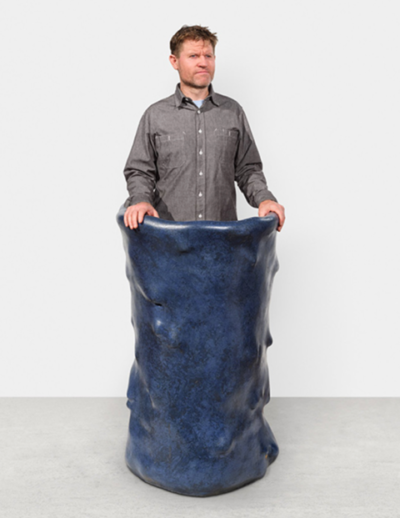
Nathan Lynch ceramic sculptor w/ Speech Aboard the Iceberg, 2021, glazed ceramic, 44 x 28 x 284 inches. Photo by John Janca
Price recognized Lynch’s potential. However, he wouldn’t find another teacher who made as much of an impression until he attended Mills College for graduate school. There, he met Price’s friend and contemporary, Ron Nagle, a sculptor of equal stature. “At the time,” Nagle recalled, “ceramics was pretty narrow in terms of what was expected, but Nathan broke out doing all kinds of neat stuff. He became extremely prolific, started to develop his own style based on stuff he had been exposed to.”
At Mills, Lynch collaborated with dancers, musicians and other artists, inspiring a foray into performance art. On stage, Lynch felt uneasy and vulnerable. To counteract those feelings, he began wearing an orange moped helmet. “If you already look dorky or stupid, it gives you permission to make a fool of yourself,” he said. “ By making himself vulnerable, he became “more open.”
Lynch moved to the East Coast in 1999 after grad school. There, between 2001 and 2004, he embarked on his first lengthy performance project, Where is your Wheel, in which he wore his orange helmet and walked through cities (New York, Boston, Washington, D.C., Las Vegas, Aspen, Los Angeles, San Francisco, Berkeley, Edinburgh) and small towns tugging a long thick rope attached to a two-foot-diameter pine wheel. On his website, he describes the performance as “a hybrid of Neanderthal activity, dog walking, and drag racing…intended to question the habits and patterns of American culture. It was an idiosyncratic act focused on interaction with the public and aimed to challenge their perception of rationality. What began as a simple Fluxus gesture evolved into an examination of American culture, with increasing references to the environment, energy costs, and transportation.”
“People would be like, ‘What are you doing?’ and I’d be like, ‘I’m going to the post office, what are you doing?’ If you tell someone it’s art, they don’t try to solve the puzzle; they just put it in this category of things they don’t understand,” Lynch said. “Think of this guy in his big American muscle car showing it off. In a sense, it was kind of like the inverse of that.”
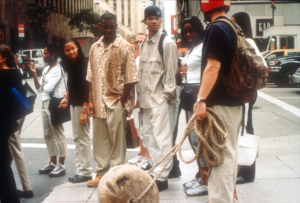 In 2002, when Lynch was at a residency in Snowmass, Colo., he applied for a teaching position at CCA. After working part-time for four years, he became chair of the ceramics program. The promotion changed his life, allowing him freedom to model his classes on anything ceramics-related. Examples include classes he’s taught about San Francisco Bay mud and the ceramic shorebird nests he made for the Farallones, Año Nuevo Island and Oahu. “I really enjoy thinking
In 2002, when Lynch was at a residency in Snowmass, Colo., he applied for a teaching position at CCA. After working part-time for four years, he became chair of the ceramics program. The promotion changed his life, allowing him freedom to model his classes on anything ceramics-related. Examples include classes he’s taught about San Francisco Bay mud and the ceramic shorebird nests he made for the Farallones, Año Nuevo Island and Oahu. “I really enjoy thinking
about what the stranger corners could be, would be, should be or might be,” he said. “Open doors, open hearts, say yes to everybody.”
The expansive environments of USC and Mills inspired him to hire teachers who would do the same at CCA. Over his two decades of teaching, he has fostered a new generation of cutting-edge ceramic sculptors. Woody De Othello, for example, was featured in the Whitney Biennial last year and has been lauded in this publication and others (Artforum and the New York Times) for his experimentation with materials and processes. It all began, says the Oakland sculptor and painter, under Lynch’s tutelage.
“Nathan is bulletproof,” said De Othello, who graduated from CCA in 2017. “He’d let you know that you don’t necessarily need to have all of the language as you process things, but you can trust the impetus with making rather than having the reason or logic to make something. He’s a force out here in the clay community and clay culture. To this day, I’ll still ask him about stuff.”
Inverness resident Mariah Nielson started studying architecture at CCA the same year Lynch was hired. She became familiar with his work when she asked if he would fabricate a line of ceramic cups modeled after hand-crafted sets created by her father, JB Blunk. He declined the job but referred her to another studio. Last year, Nielson curated Same Blue as the Sky, Studio Ahead’s first exhibit that featured the work of Lynch and other Marin County artists.
“There’s real humor there,” Nielson said of his work. “The shapes and the propositions and the suggestions. “His work really slips between the functional and the decorative, and I think he enjoys that slippage.” Lynch said prioritizing experience over functionality drives his creativity. “When I was a student, if I made something remotely functional, somebody’s always going to put a fucking flower in it: ‘Oh, it’s a vase!’ If there’s an openness or invitation, that opens up a new thing for me. For me, [a piece is] not finished until a person is interacting with it.”
Doubledrink, a three-foot-tall drinking fountain he made for the Headlands Center for the Arts, features a large basin with two spigots. The piece, commissioned in 2017, requires users to face each other as they awkwardly slurp water. In 2014, Lynch was asked to contribute to Yerba Buena Center for the Arts’ seventh Bay Area Now triennial. The tall, shimmering sculptures that now sit on either side of his driveway were part of Dead Reckoning, an interactive exhibition that addressed the precarity of human existence amid environmental and economic fragility. The forms, Lynch said, reference buoys. “San Francisco was really lost coming out of the housing crisis, and I was making these markers for finding our way,” he said. “There are a number of different buoy meanings. The best one is the unknown hazard—the one that says, ‘There’s something below here and we don’t know what it is.’”
“The Lily Too Shall Function” features work by Nathan Lynch, John Gnorski and Jessica Switzer Green @ the Jones Institute through December 10, 2023. A film by Pavló Fedorov documenting their work screens @ Minnesota Street Project, also to December 10. Artists’ talk: November 16 at 6 pm @ MSP. A version of this article appeared in the November 2, 2023 edition of the Point Reyes Light. Reprinted with permission from David Briggs, Editor.
About the Author: Sam Mondros is an Inverness-based writer and staff reporter for the Point Reyes Light. When he’s not covering western Marin County’s breaking news, he’s exploring its arts and cultural movements, highlighting the importance of legacy and place.
MEET YOUR BOARD MEMBER: JAN SCHACHTER
I have been working with clay since I was 4 years old in the basement of a ceramicist in Queens, N.Y. Here is a piece my mother saved for me!!
I did a little clay as I grew & up a bit in High School, but I guess it never let go of me.
I graduated from the University of Massachusetts, Amherst with a B.S. in Microbiology in 1963.
I think my education in the sciences enhanced my abilities as a potter to deal with the glaze components and weigh and mix my own glazes. I returned to clay part time shortly after college and attended numerous classes at Greenwich House Pottery, New York City, Old Church Cultural Center, Demerest, New Jersey and Clay Art Center, Port Chester, New York. In 1977, I was the founding director of The Gallery at Hastings on Hudson, a non-profit municipal gallery. I was also a founding member of the Hudson River Potters, a potters mutual support group. My family and I moved to California in 1978, and I have been a full time potter ever since. I have had pots in numerous national & international exhibitions.
When we moved to Palo Alto in 1978, I immediately found the Palo Alto Cultural Center, now Art Center, ceramic studio, and that got me going full time. I met a more experienced potter there from Ohio, Kathy Veverka, and together we rented an old garage in Mountain View on Old Middlefield Way. We bought an Olsen 24 kiln kit, put in the gas line and set to work. Kathy was only there a few years, and she moved back east, but I sustained the studio myself. Of course, the property got developed, so my next studio was in the office of a vacant lumber yard in Palo Alto on Homer Street – right off of El Camino. I moved the Olsen 24 and got it going. This is where the Palo Alto Medical Foundation is now located. A move was a must. In 1993 my husband & I bought a wonderful house in Portola Valley. It did not have a space adaptable to a studio, but we built one behind the garage. Having rented a couple of spaces, I knew exactly what I wanted, and we built it from scratch – and of course, I moved my Olsen 24 again. That makes it over 40 years old – and with some gentle repairs – it still fires great. I used to bisque in my Olsen, but got an electric kiln for bisque when I started my PV studio.
Through the years I have done extensive travel over much of the world and always focused on the local crafts – and of course especially ceramics. My other crafts passion has been textiles. I learned to sew, knit, embroider, crochet and weave. I still do some mending. My handles & lids have a bit of a textile base. But the big move was when I started ‘weaving’ extruded coils of clay into ‘plates’ or wall hangings. Here is a closeup of one from 2006 and a picture of one of my newest ones.

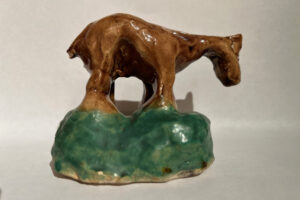
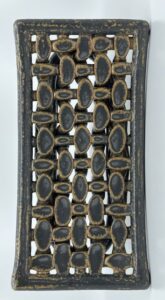
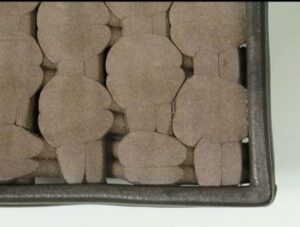
I primarily make pots for everyday use; each is a subtle variation of a form – usually created in a series. I am a perfectionist (as much as the process allows) and am constantly in search of the perfect surface and ideal form while striving to create pots that have life and vitality. I love having the opportunity to fire in a wood kiln and make special work for that to take advantage of the ash and heat.
I joined ACGA in 1982 or so, after seeing an exhibition of ACGA artists at the Palo Alto Cultural Center. The jurying was of course ‘live’ and it was done in the Le Beau Gallery (not sure I have that name spelled right) in downtown San Francisco. I have vague memories of setting up my work on the landing of the stairway within the gallery. I was asked to join the board fairly early on, and became the recording secretary briefly a treasurer, a Vice President, and then President from 1991 – 1993.
In addition to being a potter, I am an advocate for crafts and the life of a crafts person. I was on the Board of Directors of the Craft Emergency Relief Fund (now CERF+) from 1992-1997 and on the Advisory Board of Watershed Center for the Ceramic Arts in Maine for 2 years. I was on the board of the Palo Alto Art Center Foundation for 10 years and was co-president in 2009-10. In addition, I am on the Editorial Advisory Board of ‘Ceramics Monthly’.
Submitted by Jan Schachter
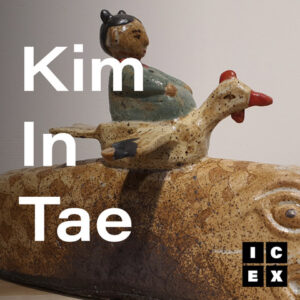

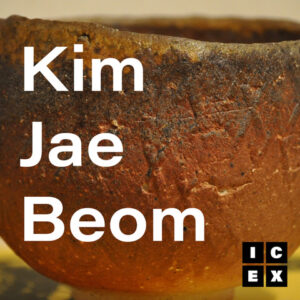
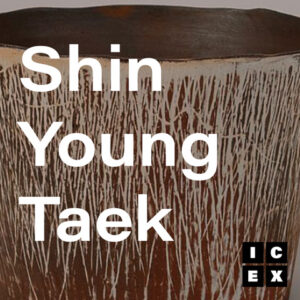
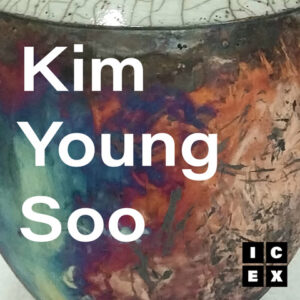
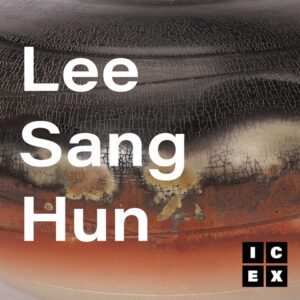
In 2018, International Cultural Exchange Week was created by Miki Shim with support from Palo Alto Art Center with the invitation of two Korean Ceramic artists and Adam Field presenting workshops, demos and exhibitions at Palo Alto Art Center, Higher Fire in San Jose and Sonoma Community Center. The concept was to invite international ceramic artists and pair with other renown US artists practicing similar artforms. The following year, 2019, four renown Chinese ceramic artists and Hsin Chuen-Lin presented workshops and demos in Palo Alto and Sonoma, plus 10 visiting Chinese artists were invited to exhibit at the Art Center. A third event was scheduled for 2020, highlighting Japanese artist, ceramics, Ikebana and tea culture. But COVID shut us down.
The re-imagined International Ceramics Exchange (ICEX) returns to the vibrant city of San Francisco. Hosted at the SOMArts Cultural Center, this three-day event promises a unique cultural journey into the heart of Korean ceramic artistry that transcends time and tradition.
ICEX:2024
ICEX: International Ceramics Exchange
Come join us at SOMArts in San Francisco, CA, USA
for an unforgettable cultural experience!
Immerse yourself in the captivating world of Korean ceramics as the International Ceramics Exchange (ICEX) 2024 returns to the vibrant city of San Francisco. Hosted at the SOMArts Cultural Center, this three-day event promises a unique cultural journey into the heart of Korean ceramic artistry that transcends time and tradition.
ICEX 2024 proudly presents six distinguished Korean ceramic artists, each a master of their craft, converging in San Francisco to share their expertise, innovative techniques, and rich cultural influences. Join us for an exploration of the ancient and contemporary as these artists— Kim YoungSoo, Kim InTae, Kim JaeBeom, Shin YoungTaek, Lee SangHun, and Lee JinWook, unveil some of the secrets behind their renowned creations.
Discover the diversity of Korean ceramics as these artists showcase specialties such as Naked Raku, Buncheong, Traditional Coil & Throw, Porcelainware, Cobalt Painting, Sanggam, and Korean Traditional woodfire techniques. Through engaging demonstrations and insightful presentations, guests will gain an intimate understanding of the artists’ processes, bringing to life the intricacies of this ancient art form.
This exchange transcends borders, offering a rare opportunity to witness the fusion of tradition and innovation in Korean ceramics. Whether you are a seasoned ceramic enthusiast, a collector, or a business looking to align with the arts, ICEX 2024 invites you to be part of this important cultural event.
For more information and to secure your participation, click the link below to purchase general admission tickets. There are additional options to become a VIP attendee or Sponsor, as well.
Your journey into the enchanting world of Korean ceramics awaits!
Friday Night Artist Reception and Exhibition
March 29th, 6-8pm, SOMArts Main Gallery, SF
Free and open to the public
Meet the artists and see their works on exhibition in the main gallery. RSVP requested by registering for the event.
Saturday and Sunday Open Demo and Exhibition
March 30-31, 11am – 4pm, SOMArts Main Gallery, SF
Ticket holders will have the rare opportunity to watch the artists work in an open demonstration setting. A “spotlight” schedule will allow each of the artists to offer short demos or presentations throughout the weekend.
Artists’ work will also be displayed and offered for sale with 100% of the sales proceeds going to the artists.
All events will be held at SOMArts, Main Gallery.
934 Brannan St, San Francisco.
Miki Shim is a small batch ceramic artist working in her home studio in San Carlos, California. Since relocating to the Bay Area from Chicago, Illinois, she spent 7 years at the Palo Alto Art Center as Associate Programming Coordinator, served as a board member of Association of Clay and Glass Artists of California (ACGA) and also on the board of Orchard Valley Ceramic Artists Guild (OVCAG), she has lead many programs to bring the ceramics community together through education and inspired engagements. Currently, she is a committed instructor at local ceramics studios, travels to teach workshops, and produces ceramics focused tours in the US and South Korea.
Submitted by Miki Shim : www.mikisr.com
INTRODUCING
NEW FESTIVAL MEMBERS FOR 2024
NEW FESTIVAL MEMBERS FOR 2024
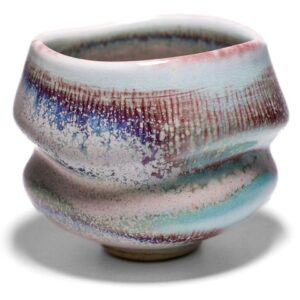
A career change led me to start taking classes at my local community college and it was there that I took my first ceramics class. Since then, I have attended dozens of workshops and firings throughout California, and the recent years have been spent creating a more cohesive body of work. My work is mostly wheel thrown and altered to create movement and supple shapes. I primarily soda fire and use specific glaze that are designed to move with the undulating curves of the piece. Im very excited to be a part of the ACGA!
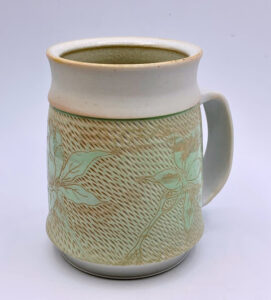
Stephen Ruby’s interest in wheel throwing initially pulled him into the medium, however, over time he has grown to explore and incorporate elements of hand building, mold making and even printmaking into his work as well. Over time, surface decoration took a front seat to his process using floral motifs as the backbone to his design. Beginning by taking classes at CCSF in San Francisco, and working for many years in studios as assistants and technicians from the west to the east coast, he soon found himself teaching classes and producing work full time. For over 15 years Stephen has been instructing students through classes and workshops while working on developing his artwork. In 2015, Stephen co founded Merritt Ceramics, a community driven pottery studio, offering classes, workshops, memberships and private events while he continues to produce his work. Recently reconnecting with one of his early mentors has given him the opportunity to return to high fire reduction firings after over 10 years of firing in oxidation. Stephen sees this as an opportunity to step up his production and especially his quality of work after having little time to focus on his work the last 5+ years due to prioritizing the founding of Merritt Ceramics.
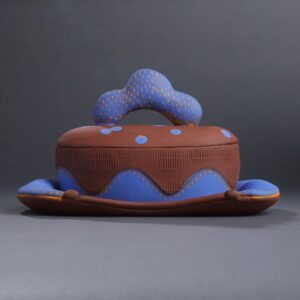
Deb Sullivan has been making art with clay for over 30 years! Everything, whether a mug or a sculpture, is a unique, one-of-a-kind art piece. There is nothing neutral about her art! She uses bold, playful shapes and colors. Her work, often described as “happy,” offers every home a pop of joyful color.
Her mid-fire work is made using an electric kiln. In an effort to make her art practice as green as possible, she recycles and re-uses all her clay scraps. Glazes for all functional art are food, dishwasher and microwave safe.
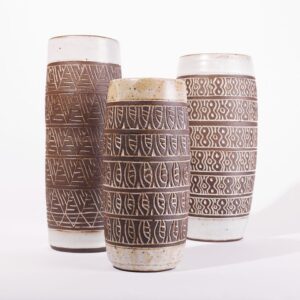
I am a ceramic artist who works out of an amazing studio full of creative ceramicists in the heart of San Francisco. My focus is on functional pottery. All of my pottery is wheel thrown using stoneware or porcelain clay bodies and fired to a high temperature.
My functional pottery is as much about how it feels as it is about how it looks. I am especially interested in and fascinated with surface treatments, particularly carving. Sometimes I plan out a carving but most often I have no idea where it will end up, and it is this process of discovery that is so exciting to me. Each piece is carved without rulers or measurements resulting in unique designs with imperfections and differences.
Global travels inspire much of my work. I am drawn to the aesthetics of indigenous design and vibrant colors.
My work has been featured in various art shows and fairs (see below for a list). Sign the email list to stay in contact and be notified of upcoming shows and new pieces ready for sale.
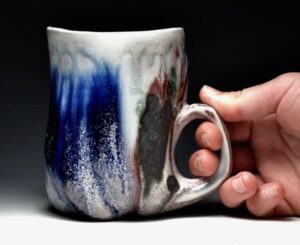
Liz Mazurek received her BFA degree in ceramics at Southwestern University in 2018.She has exhibited her work regionally and nationally including events in New York, California, Pennsylvania, Texas, Louisiana, Colorado, and more. She completed her first two-person exhibition in the spring of 2018.
In the fall of 2018, she moved to Fort Collins, Colorado to complete a year-long post baccalaureate program at Colorado State University. She lived in Fort Collins for four years teaching ceramics and working independently. She now lives in Santa Cruz where she works independently and teaches ceramics.
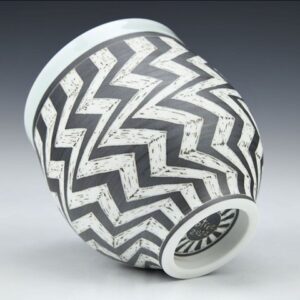
Bobby Free is an artist who works mostly with porcelain at high fire temperatures. Bobby attended Utah State University in Logan, Utah from 2006-2010 where he received his Bachelors of Fine Arts degree. After college he moved to Helena, Montana to be a production potter for Free Ceramics until 2012. He completed several Artist in Residency programs including the Clay Studio of Missoula MT, the Redlodge Clay Center MT, and the Sonoma Community Center, CA. In 2013 Bobby moved to Los Angeles, California and began work as the Studio Manager/Technician for the American Museum of Ceramic Art in Pomona until 2016 when he became the full time, Sr. Laboratory Technician of Art at Saddleback College in Mission Viejo, CA, where he still works. He lives and maintains his own studio in San Juan Capistrano, CA with his wife and two sons.
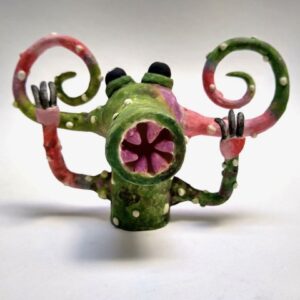
The inspiration for my ceramics is drawn from the natural world of animals and plants, and from the speculative stories we conceive of monsters and aliens. My passion lies in hand-made sculpture that is intimately held, observed from different angles, eliciting various emotional responses, provoking storytelling, and technically challenging to execute.

Form, pattern, and texture—these are the significant elements of my work. Through the paper resist technique, I am always exploring an infinite variety of combinations of clay and slip that maximize the appeal of these elements.
I design and hand-cut distinct paper patterns for each artwork. Then, using the ceramic body of the piece as a canvas, I lay out these paper patterns on it. After applying the original slip or glaze slip (which I make) over it, I peel off the patterns. Before the bisque and the final firing, I add the finishing touches carefully and repeatedly by hand.
In my work, I make two-dimensional patterns look three-dimensional through the placement of the design on the organic curve. The asymmetry and dynamic composition in my work was influenced by my experience of studying Japanese Middle Age art on folding screens, ink paintings, sliding screen paintings, and illustrated scrolls in my early days as an art history student.
I was born in Tokyo and raised in Yokohama, Japan. In my final year as an art history student at university, I decided to enroll in a design school, which opened the way to my creativity. Following design school, I began my career as an industrial designer. Then, I completed a master’s degree in industrial design. While working as an industrial designer again in Tokyo, I encountered the world of clay and started learning hand-building at a ceramic studio. After moving to the United States in 2005, I began learning wheel throwing. Since then, I have been enjoying and challenging my creativity in my studio in Orange County, CA.
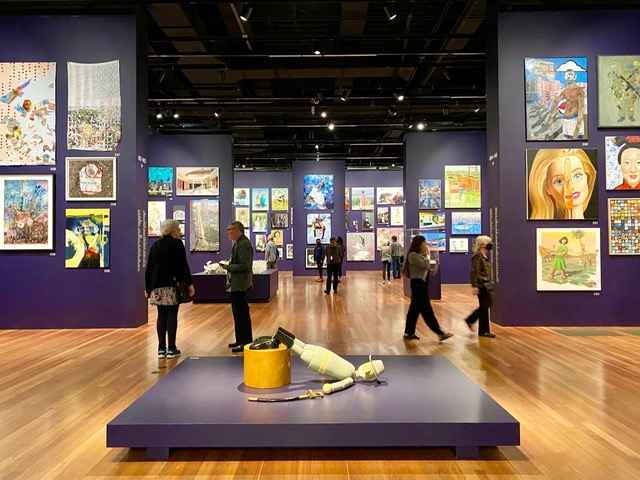
THE de YOUNG OPEN 2023
Sept 30 -2023 – Jan 7, 2023
The de Young Open 2023 runs through January 7, 2024, at the de Young Museum in Golden Gate Park, which stands as the pinnacle of exhibitions hosted by the Fine Arts Museum of San Francisco. This grand display showcases 883 carefully selected artworks out of 7,766 submissions. The presentation adopts a “salon-style” layout, arranging pieces nearly edge to edge in multiple rows to offer the broadest representation possible.
Focused exclusively on art crafted within the past three years by Bay Area artists, the exhibition’s thematic groupings highlight the diverse artistic expressions found in the region. Spanning various mediums and styles, it serves as a testament to the rich and varied talent thriving within the Bay Area. Artists exhibiting their work in one of the nation’s premier museums not only gain prestige but also have the opportunity to sell their pieces, keeping 100% of the proceeds. View Web Gallery
Among the featured artists, the exhibition showcases sculptures by ACGA members Scott Jennings (#585) and Mari Emori (#559).
Since its unveiling in late September, the exhibition has garnered rave reviews by local and international media.
“It’s a dizzying, bursting-at-the-seams extravaganza of an exhibition, designed through an open call process to take the pulse of what local artists are thinking and making.” — The New York Times
“Instead of gatekeeping, the de Young has thrown its doors open. Instead of featuring two or three major name national or international artists for ‘blockbuster’ fall exhibitions, the de Young placed its emphasis on local artists–and did they ever respond!” — Forbes
“It’s a dazzling tsunami of painting, drawing, printmaking, fiber, photography, sculpture, video, and digital art.” — Hyperallergic
The de Young Open 2023 remains a must-see, concluding on January 7, 2024. Admission is free to all on Saturdays, although entry to the exhibition on Saturdays requires a timed ticket. Don’t miss the opportunity to experience this extraordinary showcase of Bay Area creativity.
Submitted by Mari Emori
Call for Nominations for the ACGA Board of Directors
Now is the time to nominate yourself or another ACGA member for a seat on the Board of Directors. The ballot will go out in early January, and votes will be tallied by January 20. Results will be announced via email and at the All-Member Meeting on Saturday, January 27. The election is for a two-year term.
Our Board is a vibrant, creative group of ACGA members who enjoy working together to run the organization. We oversee exhibitions, social media and newsletter content, membership, the annual Clay and Glass Festival, finances and budgeting, twice-a-year festival juries, website content, and anything else that strengthens the ACGA community.
Joining the Board is an excellent way to add your voice and opinions as we navigate toward our goals. Monthly meetings are held via Zoom, and because we now meet online instead of in person, we’re looking for nominations from anywhere in the state.
Consider putting your name or the name of another member on the ballot this year.
Submitted by Sally Jackson, ACGA Secretary
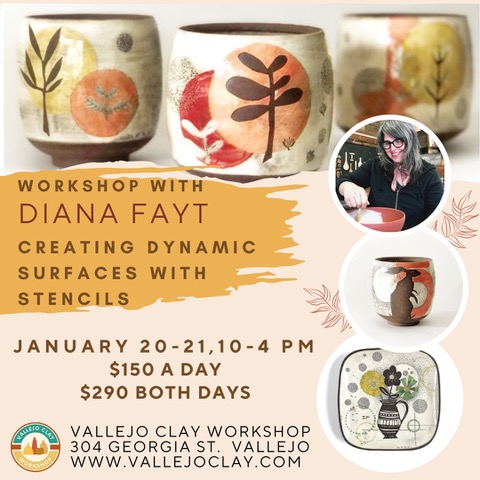
Discover the art of beautifully layered and graphic ceramic surfaces with eye-catching imagery in our hands-on workshop led by visiting artist Diana Fayt.
Dive into her beautiful world with us as she shares with you her techniques for creating stencils made from your own designs. She will cover what materials to use, how to transfer your artwork to the stencil material, how to cut out stencils, including what details to emphasize when creating stencils. From simple to complex, these stencils can be re-used over and over so you can swiftly and easily create colorful artwork on your ceramic surfaces.
Witness the magic as Diana showcases the application of these stencils using colorful underglazes on both flat and curved, leather-hard clay surfaces. Delve deeper by exploring the layering technique with multiple colors and discover how to create mesmerizing relief images that breathe life into your pottery.
On the second day Diana will guide you through more advanced ways to use stencils to create even more depth and richness to your clay surfaces. She will show you how to incorporate stencils with her lo-tech newsprint transfer method, how to use carving to enhance your stencil images and how to incorporate overall color onto your clay surfaces. To round out the workshop, Diana will also share how she uses glaze to create yet another layer of interest.
Join us for this special and immersive experience with a master visiting artist, and take home not just pottery but a newfound skill set to elevate your artistic expression!
This is a 2 part workshop that can be taken as a 1 or 2 day workshop.

NICHIBEI POTTERS OPEN HOUSE & HOLIDAY SALE
Visit the Nichibei Potters showroom in Sebastopol Ca to see our latest offerings. Mugs, bowls, carved work and more!
1991 Burnside Rd., Sebastopol, CA hours hours December 16 & 17, Saturday & Sunday, 10 to 4
THREE-DAY HANDS-ON WORKSHOP WITH CERAMIC ARTISTS BOB BRADY & SANDY SIMON
HOW THEY DO IT
FRIDAY, SATURDAY & SUNDAY, JAN 26–28, 2024, 10AM–5PM
In this three-day, hands-on workshop, Berkeley-based master potters Sandy Simon and Bob Brady will demonstrate and work with participants to teach their techniques for throwing, creating new forms, trimming methods and surface decoration and resolution. Bob will demonstrate dry-throwing for bowls of all sizes, drawing through slip, paper stenciling with slips, foot-trimming techniques, various forms of thrown and altered vases, large thrown jar forms and cups. Sandy will demonstrate how she works with porcelain, focusing on lids of all kinds and how to make inside and outside flanges. We’ll be working with Cone 9/10 stoneware and porcelain. Expect lively conversation and discussion about life as full-time potters, running a gallery and the different ways they approach working in clay.
Bob Brady is a San Francisco Bay Area sculptor who works in ceramics and wood. Brady came out of the California Clay movement and the Bay Area Arts scene of the 1950’s and 60’s, which includes artists such as Peter Voulkos, Viola Frey, Stephen de Staebler, and Robert Arneson, who was his mentor and teacher in college. Brady attended the California College of Arts and Crafts in Oakland before entering the University of California, Davis, where he received his MFA in 1975. Brady has lectured and taught workshops nationally and internationally and was a Professor of Art at California State University, Sacramento for 33 years. His work is in numerous private and public collections.
Sandy Simon was a student at the University of Minnesota in the late 60′s studying under Warren MacKenzie and Curt Hoard, having contemporaries such as Mark Pharis, Wayne Branum, Michael Simon,and Randy Johnston as her classmates. Sandy is a studio potter and in 1994 opened TRAX Gallery in Berkeley, CA to provide greater representation for ceramicists dedicated to utility.
Advanced-Beginner to Intermediate Wheel-Throwing Skills are required.
Cost: $500 (PS members & PS students $425)
Enrollment is limited.
To Register for this workshop:
email events@berkeleypottersstudio.org.
Submitted by Sandy Simon
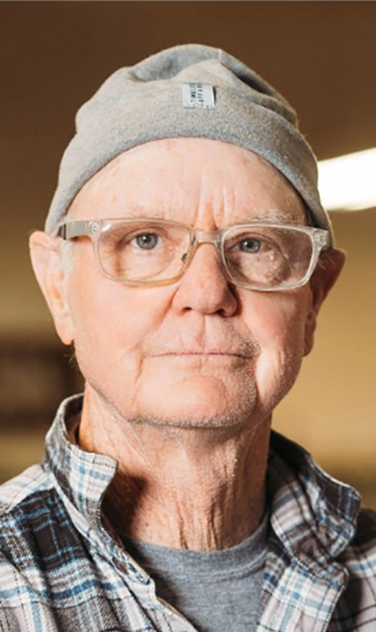
Bob Brady

Sandy Simon
BIG BACK YARD SALE AT TRAX GALLERY
One Day Only
December 23, 10 -4
1812 5th Street, Berkeley, CA 94710
TRAX is having a big back yard sale on Sat., Dec. 23rd.
Great deals on pots by many different potters, some seconds, clearance of many wonderful thigns, greatly reduced pricing on all pieces. Cash and Carry
Submitted by Sandy Simon

KATHY PALLIE is pleased to announce that three of her “Facets of Light” ceramic artworks will be in The Small Works Exhibit at Art Works Downtown Gallery at 1337 Fourth St., San Rafael.
The exhibition can be viewed Nov. 18 -Jan. 20, 2024. Thursday – Sunday 1 – 8pm.
There will be an artist reception linked with art walk Jan. 12 from 5:00. -8:00.
REMEMBERING CAROLYN MEANS
Carolyn Means passed away peacefully September 10, 2023 in her home in San Anselmo.
Carolyn grew up in Connecticut and went to Wellesley College in Massachusetts majoring in English literature. After colleges she moved to California and taught 3rd grade in the East Bay. Carolyn took a pottery class at Richmond Art Center, and she enjoyed it so much that she continued, finally becoming a potter herself, Moving to San Francisco, buying her own house in Noe Valley, she built a high fire gas kiln in her backyard. She participated in the San Francisco art and craft shows at the SF civic center plaza, and also in the SF Potters Association sales during the 70’s and 80”s in the hall of Flowers in Golden Gate Park, continuing in those sales at the Palo Alto Cultural Center. Carolyn traveled to Italy in the early 80”s and helped set up a ceramics course in an old flower pot factory which was part of the Scuola di Visione in Tuscania led by the painter, Rudolf Kortokraks. He had been first assistant to Oskar Kokoschka at the Summer Academy for Art in Salzburg and continued the school in Tuscania Italy.
Carolyn finally moved to San Anselmo and moved her Pier 9 pottery to Point Reyes Station. Carolyn loved to work hard, to experiment with her ash glazes, getting the results she wanted. In Point Reyes she fired with a large Quile gas kiln. She had transitioned from her copper red glazes to both Shino and ash glazes. She had a devoted following that came to her sales in SF, Palo Alto also and at her studio in Point Reyes. Carolyn had a major exhibition at the Bolinas Museum a few years ago. It was very successful and nearly all the pieces were sold.
Carolyn had a great love of the Italian language and loved reading books by contemporary Italian authors in their own language. She also found inspiration in the colors of the local Italian landscape, sketching and drawing with carefully chosen colored oil pastels from the high end art shops in Florence or Rome. Working with Kortokraks, she discovered about making pictures on paper at which she worked hard. I think all this influenced her pottery.
Carolyn leaves behind many beautiful pots and many devoted friends.
Submitted by Mardi Wood

HOW TO POST YOUR NEWS AND EVENTS TO THE ACGA WEBSITE AND SUBMIT ITEMS FOR THE NEWSLETTER
Our communications tools now allow members to post their news items directly to the ACGA News Blog, for daily publication. Posts must be admin-approved and may take up to 48 hours to appear in the blog. Incomplete submissions may take longer. The web-based news blog is a living document and posts items in the order they are published. You can scroll through the entire history of the ACGA News here: https://acga.net/acga-news/.
In addition, our monthly ACGA newsletter is emailed to approximately 5500 subscribers. This news is less time-sensitive than more immediate forms of communication such as the news blog and our social media accounts on Instagram and Facebook.
Social media is the most effective and most instantaneous way to reach your audience, provide a platform that can be posted to repeatedly and often. We encourage members to cultivate their own social media accounts on facebook and instagram, to build your own audience and market your wares. We are happy to amplify your message to our followers from time to time when the following conditions are met:
- Captions must include who, what, where, when details.
- Posts must relate to something a collector or student can engage with such as a gallery event, an open studio, or an upcoming sale. Posts that lack context will not be reposted.
- We will not repost items projecting more than 2 weeks in the future.
- Posts should be tagged @theacga to ensure we can find them
ACGA social media accounts have more than 17,000 followers, so following these guidelines could be valuable to you. News items must be written in grammatically correct form, include all details including names (first and last) of members involved, links to artist websites or social media, studio or gallery locations and hours of operation.
Be aware that we have over 350 members and will strive to be fair and equitable, and to showcase the wide variety of accomplished artists who comprise our group. Publication is not guaranteed, and is not a perquisite of membership. If you have an event with frequent updates or an extended window of time, we expect you to manage your news on your end and we may or may not repost at our discretion.
ACGA GENERAL MEETING MINUTES – NOVEMBER 13, 2023
Date of Next Meeting: Monday, December 11, 2023, 5:30pm
READ NOVEMBER MEETING MINUTES
All ACGA members in good standing are invited to attend our monthly board meeting on zoom. To receive a zoom invitation for the next meeting, email your request to Mari Emori, emori.mari@gmail.com.
LISTINGS
SEE EVENTS CALENDAR:
https://acga.net/events-calendar/
This space is envisioned for future listings of upcoming calendar events. Since we have only just launched the submission process in this mailing, we do not have any current events at this time. Please follow the submission process outlined herein.
Professional Kiln Repair Service
NorCal Kiln Repair- “Professional Bay Area repair service since 2006”
· evaluation & repair: ceramic & glass kilns (gas & electric)
· tutorials: operation, safety, maintenance, custom programming
· evaluation & repair: pottery wheels, pug mills, slab rollers
· ventilation repair & installation / studio safety & setup consultations
· new & used kiln recommendations / appraisals: buying & selling
· ceramics troubleshooting: clays, glaze, construction, firing, etc.
Joseph Kowalczyk (Ko-väl-chick)
kiln & ceramics specialist
510 601-5053 · NorCalKilnRepair@gmail.com
www.norcalkilnrepair.com
ACGA NETWORKING EXPLAINED
Address changes and Membership Changes – Please send all address changes to the membership chair EmilYanos,
acgamembership@gmail.com
ACGA’s Website – Check out our website
The home page now features an ‘artist of the month.’ Populate your own page, and update often. To create and edit your profi le page, go to the For Members menu, choose Member login, and follow the instructions to find and edit your profile.
Need a website password? Email Emil Yanos at
acgamembership@gmail.com
We look forward to hearing from you!
Follow and Like us on FaceBook (@ClayandGlass) and Instagram (@theACGA)
The ACGA News is sent through MailChimp. If your email bounces you or you have been unsubscribed, you can sign up again – contact Communications Lead Ren Lee at: news@acga.net.
Join the ACGA social media group www.facebook.com/groups/ACGASocialMedia
GOOGLE GROUP
Link to the Google group: the-acga@googlegroups.com
To email all members via the ACGA Google group you must be a member. Address your clay/glass-related message to: the-acga@googlegroups.com
There are two ways that you can engage in google groups without a gmail account:
1. Via email only
With a non-gmail email address you can still participate in all of the google group activities by replying to emailsand/or sending an email to the-acga@googlegroups.com to start a new thread. You do not have to create any google accounts to do this. If you’re seeing this email, then you’re in the group and can respond to emails like this one that will be sent to the entire group.
More details on how to create and respond to google group messages in the FAQ!
2. Make a google account
While it’s not necessary to have a google account to participate in the google group, you can create one with your non-gmail email address to get access to the google group site, which just aggregates the ACGA google group conversations in one place that’s easy to review and search.
Board of Directors – 2023
2023 Officers
President: Mari Emori
Vice President: TBD
Secretary: Sally Jackson
Treasurer: April Zilber
Lee Middleman, Jan Schachter, Joe Battiato, Emil Yanos, Trudy Chiddix, Cheryl Costantini,
Chris Johnson, Ren Lee, Susie Rubenstein, Iver Hennig, Sonja Hinrichson, Vicki Gunter, Barbara Prodaniuk
Committee Chairs
Communication – Ren Lee
Exhibitions – Jan Schachter
Festival Liaison – April Zilber
Festival Jury Coordinator – Chris Johnson
Historian – Cuong Ta
Int’l Ambassador – Barbara Brown
Membership Coordinator – Emil Yanos

